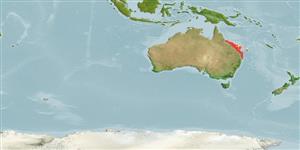Common names from other countries
Environment: milieu / climate zone / depth range / distribution range
Ecologia
marinhas demersal; intervalo de profundidade 12 - 65 m (Ref. 39597). Tropical; 18°S - 28°S (Ref. 77064)
Western Pacific: Queensland, Australia.
Tamanho / Peso / Idade
Maturity: Lm ? range ? - ? cm
Max length : 13.0 cm TL macho/indeterminado; (Ref. 3132)
This species of waspfish has the following characters: gill rakers 12-15 (mode 13); posterior
tip of depressed pelvic-fin spine usually not reaching anus; relatively long upper-jaw, its length 16.5-20.1% of SL, mean 18.6%; relatively deep maxilla, its depth 5.8-7.6% of SL, mean 6.4%; longest anal-fin soft ray is relatively short, 21.5-25.9% of SL, mean 24.6%; a large first blotch, narrow and vertically oriented (mean width 12.9% of SL, mean height 24.6% of SL), lateral line running through middle of blotch; relatively large second blotch (mean width 9.6% of SL, mean height 7.9% of SL), located at base of first dorsal-fin soft ray and upper part of blotch extending onto fin membrane; usually with a third blotch on lateral line below soft-rayed portion of dorsal fin; sometimes the second and third blotches are merged together (Ref. 77064).
Little is known of the species' biology, taken in trawls (Ref. 39597).
Life cycle and mating behavior
Maturities | Reprodução | Spawnings | Egg(s) | Fecundities | Larvas
Motomura, H., P. Last and J.W. Johnson, 2008. Review of the waspfish genus Liocranium (Scorpaeniformes: Tetrarogidae), with restoration of L. pleurostigma (Weber). Zootaxa 1820:27-40. (Ref. 77064)
Categoria na Lista Vermelha da IUCN (Ref. 130435)
CITES (Ref. 128078)
Not Evaluated
Utilização humana
Pescarias: espécies comerciais; Aquário: Espécies comerciais
Ferramentas
Relatórios especiais
Descarregue XML
Fontes da internet
Estimates based on models
Preferred temperature (Ref.
115969): 24.3 - 26.3, mean 25 (based on 64 cells).
Phylogenetic diversity index (Ref.
82804): PD
50 = 0.7500 [Uniqueness, from 0.5 = low to 2.0 = high].
Bayesian length-weight: a=0.01905 (0.00780 - 0.04657), b=3.03 (2.82 - 3.24), in cm Total Length, based on LWR estimates for this (Sub)family-body shape (Ref.
93245).
Nível Trófico (Ref.
69278): 3.2 ±0.3 se; based on size and trophs of closest relatives
Resiliência (Ref.
120179): Médio, tempo mínimo de duplicação da população 1,4 - 4,4 anos (Preliminary K or Fecundity.).
Fishing Vulnerability (Ref.
59153): Low vulnerability (10 of 100).
